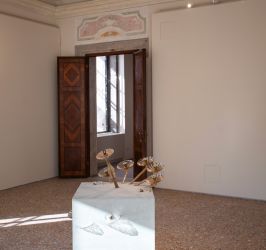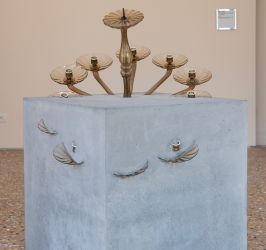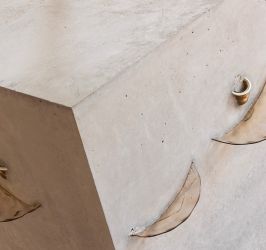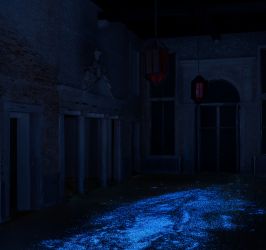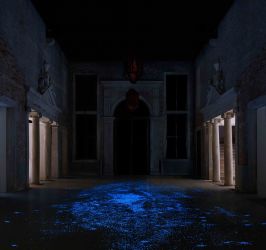Piero Golia
1974, Naples, Italy
He lives and works in Los Angeles, USA
A complex and pragmatic artist, a multifaceted provocateur with a neo-Dada imprint, he has made his mark on the international scene with performance actions pushed to the edge of reality that point out the contradictions of contemporaneity with lucid irony.
temporary artwork
Concrete cube
with glass chandelier
2024
Concrete, steel reinforcement, and glass chandelier
A versatile and provocative artist of a neo-Dadaist stamp, he has gained recognition on the international stage through performance pieces that push the boundaries of reality, highlighting the contradictions of contemporary society with sharp irony.
This artwork consists of a concrete cube with a glass chandelier embedded within. The concept is straightforward: submerge an object in concrete and then wait until the concrete sets, trapping the object forever, eliminating its functionality and relegating it to realm of sculpture. Seeming to have just fallen from the eighteenth-century ceiling of Palazzo Diedo, Golia’s sculpture freezes the moment, juxtaposing the fragility of glass with the timeless solidity of concrete, metaphorically exploring the dynamics between tradition and modernity.
Courtesy of the artist
Photos by Massimo Pistore
site-specific | permanent artwork
Untitled (floor)
2025
Marble, glass and cement
A multifaceted and provocative artist whose poetics are rooted in a Neo-Dadaist approach, Golia has carved out a prominent role on the international scene through sculptures and actions pushed to the limits of reality, revealing with sharp irony the contradictions of our time.
As is often the case in his practice, the work takes shape as an evolving experience, unfolding in two distinct phases that invite the viewer to grasp reality as it materializes.
In 2024, on the occasion of the inaugural exhibition at Palazzo Diedo, titled Janus, and in response to unforeseen delays caused by restoration work on the building, Golia chose to present the space without flooring. The materials intended for the work’s completion were displayed in plain view, along with the workers, who stood ready to finish the job.
A year later, the second phase of the project was completed behind closed doors with the final installation of the floor, perfectly integrating into the architectural context of the building.
Courtesy of the artist
Photos by Filippo Rossi / Marco Cappelletti Studio
